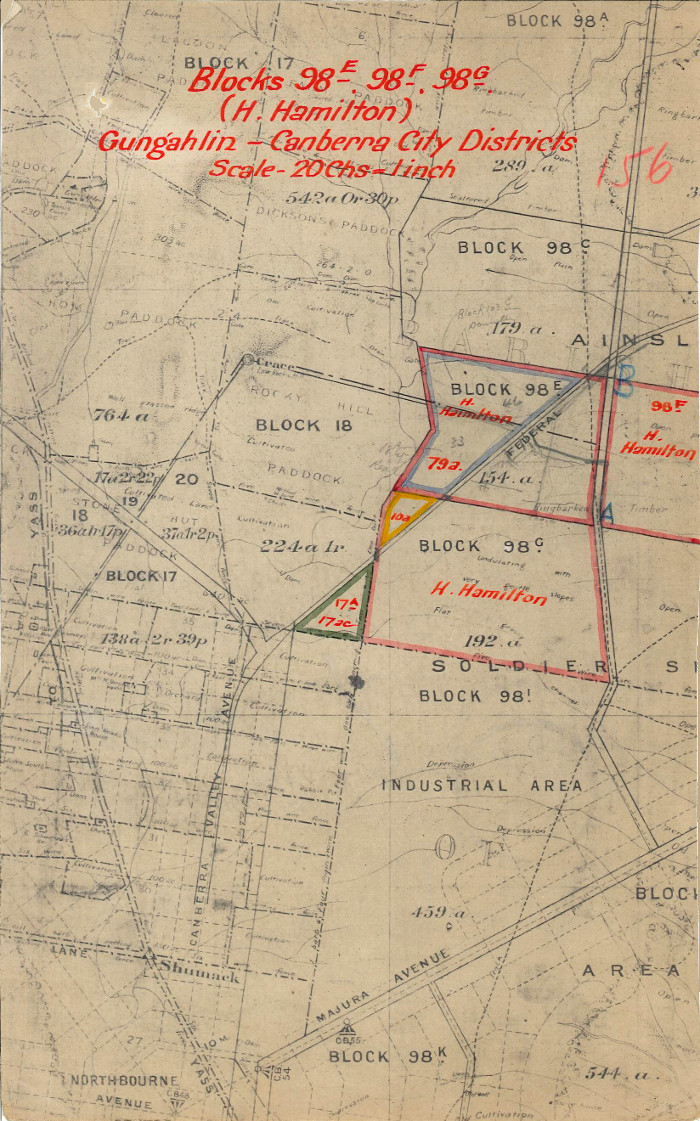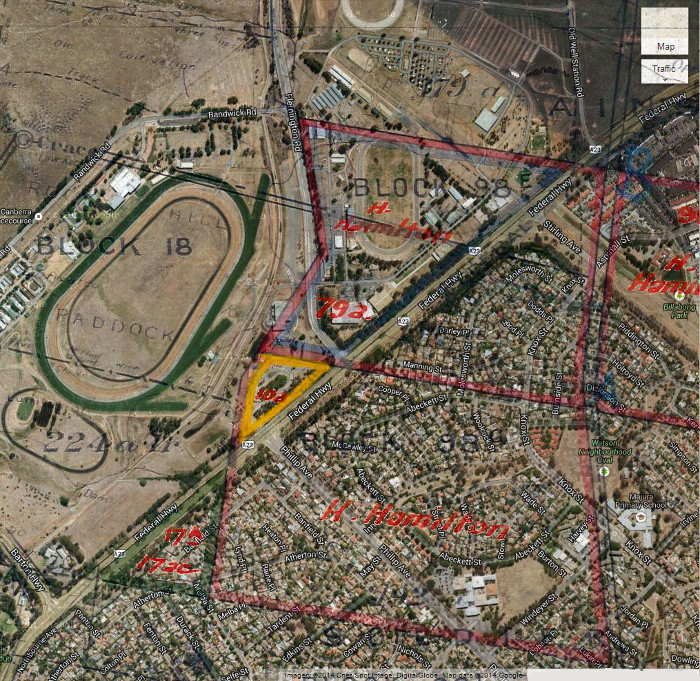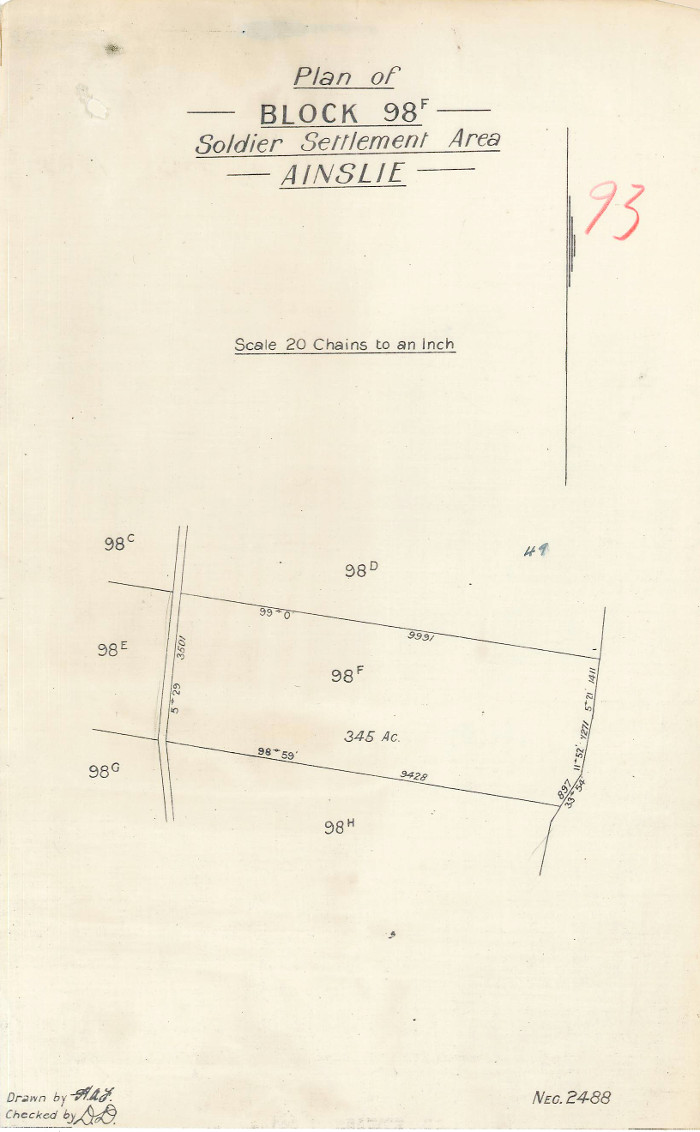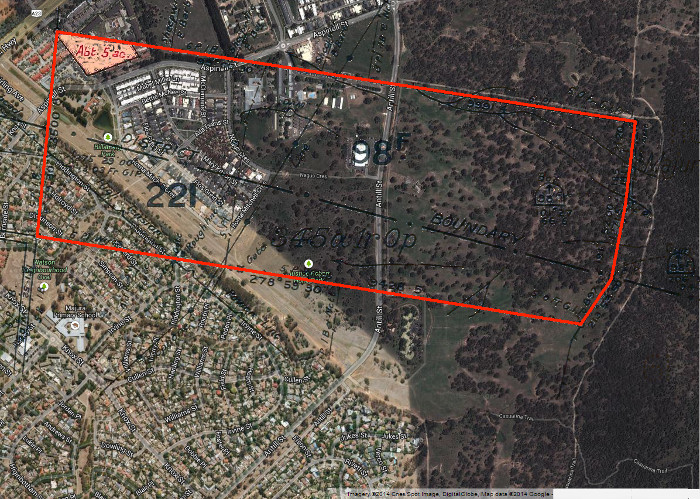Harry Murray
Blocks 98E & 98F Gungahlin District
Harry Murray was born in Surry Hills in Sydney on the 29th September 1884. Most of his early life was spent on the Monaro at Cowra Creek near Bredbo, NSW where his father, John Murray, mined gold. He was a bush worker in Dubbo, NSW when he enlisted on the 3rd August 1915. Although he embarked overseas with reinforcements for the 17th Battalion, his frontline service was with the 5th Field Company Engineers. He received a severe gun shot wound to the leg during the Second Battle of Bullecourt in May 1917, and was wounded a second time at Morlancourt in June 1918.
While convalescing in England, Murray married Elsie Cowley and they returned to Australia in 1919. He applied for land under the Soldier Settlement Scheme and was allocated Gungahlin Blocks 98E and 98F in the Ainslie Subdivision. The blocks covered part of the area later occupied by the Canberra Racecourse, Exhibition Park and North Watson eastwards to the lower slopes of Mount Majura.
Both leases commenced on the 1st January 1920 for twelve years. The annual rental was £38/10 for the 154 acre (62 hectare) Gungahlin Block 98E and £86/5 for the 345 acre (140 hectare) Gungahlin Block 98F.

Plan of Gungahlin Blocks 98E, 98F and 98G.
Murray was soon complaining about the rent. He had borrowed money from the Commonwealth to stock the land with sheep, build fences and excavate a dam. He had received notice from the Commonwealth to destroy rabbits and weeds at his own expense, which he said he was doing. He questioned why he should pay rates when there were no roads or services for the block and when about 100 acres (40 hectares) was stony ground and useless to him. The Commonwealth rejected his appeal.

Google Maps image of area c2013 with Gungahlin Blocks 98E and 98G boundaries in red.
At first the Murray's lived with his father and stepmother at The Glebe in modern day Reid. However, Elsie was not happy with the arrangement, nor with the prospect of living in a tent on their lease, so they moved to Sydney instead. Murray then arranged for his younger brother Jim Murray to look after his land, a point noted by Lands Inspector, James Brackenreg, in November 1921.

Plan of Gungahlin Block 98F.
Murray continued to have trouble clearing rabbits and keeping up the quarterly rent payments on his leases. In July 1922, he tried to assign his blocks to Norman Swan from Queanbeyan, NSW for the sum of ten shillings. He wrote to the Commonwealth Surveyor General, Colonel Goodwin that:
"I find it impossible to Carry on under Present Circumstances. The area I hold is not sufficient in itself to provide a living. Consequently I have had to take employment and am living in Sydney. Mr Swan is a returned soldier and if the transfer is granted he is prepared to take over mortgages on stock fencing etc and pay all amounts due."
He was told on 21st July 1922 that the transfer could not occur until the rabbits were cleaned up.

Google Maps image of area c2013 with Gungahlin Block 98F boundary in red.
A few months later Murray's father John advised Goodwin "my son does not see any way of getting out of the above Blocks without losing everything". John wanted to know if the blocks could be transferred to Murray's neighbour, Leo Cameron. A few weeks later Cameron bought 770 sheep from Murray and applied for a five year lease on the blocks from the 28th October 1922, the date on which the transactions were arranged. Murray wrote asking that the lease be determined from the 27th October 1922 and they were transferred to Cameron from that date.
However, Murray's financial struggles did not end after the transfer as he then had trouble finding work in Sydney. When his brother Ernest Murray acquired the lease to Woden Block 15 in 1927, he paid Murray £2 per week to look after the land.
One of Murray's biggest jobs on Woden Block 15 was to control the noxious weed known as Sweet Briar (Rosa rubiginosa). On one occasion he was trying to clear the Sweet Briar in Blundells Paddock (located within Woden Block 15). The paddock had a steep slope down to the Molonglo River and while trying to dig out the briar, Murray slipped and fell over a cliff injuring his knee and suffering cuts and bruises. He developed blood poisoning after the application of some home remedies and ended up in Canberra Hospital for ten days.
In 1931, the economic conditions of the Depression resulted in Ernest selling Woden Block 15. Murray then moved back to Sydney where he and Elsie had nine children. Harry Murray died on the 17th October 1948 in Marrickville Hospital in Sydney.
Sources
- ArchivesACT: Government Property & Tenancy Registers - Gunaghlin Block 98E (
 PDF 306Kb) & Gungahlin Block 98F (
PDF 306Kb) & Gungahlin Block 98F ( PDF 766Kb)
PDF 766Kb) - ArchivesACT: TL7794 (Part 1) - Block 98F Gungahlin - H.I. Hamilton
- ArchivesACT: TL7794 (Part 2) - Block 98F Gungahlin - (Includes Approval Drive-In Theatre Site 1955) - Hector Ian Hamiton
- NAA: (B2455) First Australian Imperial Force Personnel Dossiers, 1914-1920: http://discoveringanzacs.naa.gov.au/browse/person/247805
- Canberra's First Anzac by James Murray, 2002
- Family Notices. The Sydney Morning Herald, 18 October 1948, p.10: http://nla.gov.au/nla.news-article18096860
- ACT Memorial - Murray, Harry: http://www.memorial.act.gov.au/person.php?id=3045
